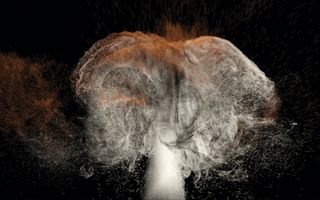Why you can trust Creative Bloq

Krakatoa is Thinkbox Software's particle renderer, designed to take
an existing particle field and use it to produce wispy, ethereal forms, like plasma or gaseous fluids. The key thing with Krakatoa is that the particles react realistically to light, so not only does it produce beautiful, shadowed volumetric results, but you also get precise control over the look simply by moving and tweaking your lights.
Krakatoa works with a range of sources: a mesh object, C4D's native emitter and Thinking Particle systems, X-Particles from Insydium, .bin files from RealFlow and .prt files from other versions of Krakatoa. You can use it to render TurbulenceFD particle flow, and there's a built-in fractal generator.
Particles can be exported to a Krakatoa .prt cache, with information baked in, such as colour, lighting, density and so on. The sequence can then be imported using the PRT Loader and rendered, or shared with other Krakatoa artists. The plug-in works much more quickly and smoothly with its native cache files, so it's well worth taking the time to generate them.

When rendering with Krakatoa, you need to understand the way particles react to light sources. You have control over their colour, emission, absorption and density values, as well the way they're rendered, and it's the cumulative effect that gives the particle cloud its desired look.
Krakatoa can render with multi-pass motion blur and depth of field, and as well as point rendering it also provides a voxel rendering system, which helps to get a softer, smokier result.
Krakatoa takes time to learn and is unforgiving at first, with an almost bewildering level of control
Krakatoa is a blazingly quick renderer, but to get the right results you often need to feed it with very large amounts of particles. If you need more you can get Krakatoa to repopulate the particle field, adding additional points. And while this is fine for lower numbers of particles it becomes unwieldy (and very slow) with larger systems.
Better then to use Krakatoa's partitioning, which saves out the same particle field with slightly randomised values. These are stored as separate .prt sequences and then loaded in and rendered en masse.
Krakatoa is a beast of a plug-in. It takes time to learn and is unforgiving at first, with an almost bewildering level of control. It's a serious piece of software at a serious price, but for studios that have looked on enviously at the work being created in 3ds Max and Maya, now you too can have a slice of the action.
Words: Steve Jarratt
Steve Jarratt has been in CG for many years. He's a regular contributor to 3D World and edited the magazine for two years. This article originally appeared in 3D World magazine issue 183 - on sale now!

Thank you for reading 5 articles this month* Join now for unlimited access
Enjoy your first month for just £1 / $1 / €1
*Read 5 free articles per month without a subscription

Join now for unlimited access
Try first month for just £1 / $1 / €1
The Creative Bloq team is made up of a group of design fans, and has changed and evolved since Creative Bloq began back in 2012. The current website team consists of eight full-time members of staff: Editor Georgia Coggan, Deputy Editor Rosie Hilder, Ecommerce Editor Beren Neale, Senior News Editor Daniel Piper, Editor, Digital Art and 3D Ian Dean, Tech Reviews Editor Erlingur Einarsson and Ecommerce Writer Beth Nicholls and Staff Writer Natalie Fear, as well as a roster of freelancers from around the world. The 3D World and ImagineFX magazine teams also pitch in, ensuring that content from 3D World and ImagineFX is represented on Creative Bloq.
